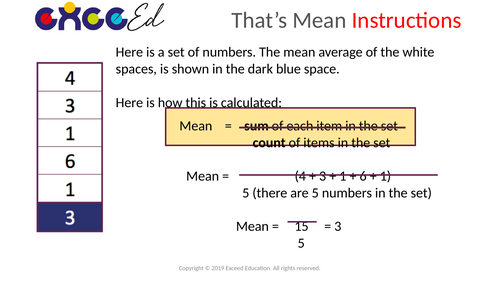

Do your children need practice solving problems and puzzles? Do you need activities that specifically practise reasoning about the mean average to help your children master the content? Then look no further than this ‘Start the Day’ activity pack.
This is the full pack which has 5 similar activities (each with teacher answers) in PDF and PowerPoint form for easy printing and sharing with your children on an interactive whiteboard.
The activity is designed to help children master mean averages by giving them three styles of practise problems:
- Calculating the mean from a set of numbers;
- Using the known mean and the known numbers in a set, to find one missing number from the same set;
- Using observed patterns in each mean, to predict a the unknown mean, and then calculate the missing number from this mean and the known numbers.
Children might choose to use a trial and improvement method for finding this unknown number, reasoning out their others answers based on their choices. Otherwise, children might use algebra to replace this unknown number with x. The answer pages the answer, to enable teacher follow up during plenary or mini-plenary discussions.
Note: It is possible that the children will find different answers for part 3 above. This does not make them wrong, and teachers should be prepared to challenge children to justify why they made the choices they did.
Tips on how to deliver these activities:
- These activities are best delivered after the children have learnt about the mean average, what it is for, and how to calculate it;
- On the first occasion you use these activities, allow children a free run at solving the puzzle, perhaps with some very minor discussion around the known numbers and how they might help;
- Allow children to talk through their strategies for finding solutions, encouraging pupil voice in both paired and whole-class discussions;
- If necessary (some children won’t find a way to solve the problem without a system), share a way to work backwards. How does knowing four of the numbers in this set, and also the mean in this set, help us to find the missing number? Etc;
- Encourage children to think about what they did to make the problem smaller;
- Ask children how they could adapt the puzzle to make it easier, or more challenging (for example through fewer clues, or multiple missing numbers);
- Use one activity per week over a half term to encourage regular revisiting of the content (finding the mean average) and strategies (working backwards/trial and improvement/algebra);
- Have children create their own versions and send them to us to challenge our followers - Twitter: @UKExceED
Get this resource as part of a bundle and save up to 38%
A bundle is a package of resources grouped together to teach a particular topic, or a series of lessons, in one place.
Something went wrong, please try again later.
This resource hasn't been reviewed yet
To ensure quality for our reviews, only customers who have purchased this resource can review it
Report this resourceto let us know if it violates our terms and conditions.
Our customer service team will review your report and will be in touch.
